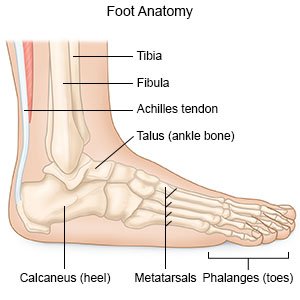Transmetatarsal Amputation
Medically reviewed by Drugs.com. Last updated on Apr 6, 2025.
Transmetatarsal amputation (TMA) is surgery to remove all or part of your forefoot. You may need TMA if you have a severe injury or infection, or poor blood flow to your foot.
 |
DISCHARGE INSTRUCTIONS:
Call your local emergency number (911 in the US) for any of the following:
- You feel lightheaded, short of breath, and have chest pain.
- You cough up blood.
Call your doctor or surgeon if:
- Your leg feels warm, tender, and painful. It may look swollen and red.
- You have severe pain.
- Your foot or toes are swollen, cold, numb, or they turn white or blue.
- Blood soaks through your bandage.
- You have a fever or chills.
- Your incision wound is red, swollen, or draining pus.
- Your splint or cast breaks or is damaged.
- You have nausea or are vomiting.
- Your wound is red, swollen, and feels warm.
- You have pus coming from your wound.
- You have questions or concerns about your condition or care.
Medicines:
You may need any of the following:
- Prescription pain medicine may be given. Ask your healthcare provider how to take this medicine safely. Some prescription pain medicines contain acetaminophen. Do not take other medicines that contain acetaminophen without talking to your healthcare provider. Too much acetaminophen may cause liver damage. Prescription pain medicine may cause constipation. Ask your healthcare provider how to prevent or treat constipation.
- NSAIDs help decrease swelling and pain or fever. This medicine is available with or without a doctor's order. NSAIDs can cause stomach bleeding or kidney problems in certain people. If you take blood thinner medicine, always ask your healthcare provider if NSAIDs are safe for you. Always read the medicine label and follow directions.
- Antibiotics help prevent an infection.
- Take your medicine as directed. Contact your healthcare provider if you think your medicine is not helping or if you have side effects. Tell your provider if you are allergic to any medicine. Keep a list of the medicines, vitamins, and herbs you take. Include the amounts, and when and why you take them. Bring the list or the pill bottles to follow-up visits. Carry your medicine list with you in case of an emergency.
Drugs used to treat this and similar conditions
Tresiba
Tresiba (insulin degludec) is used to treat diabetes mellitus. Includes Tresiba side effects ...
Humalog
Humalog (insulin lispro) is used to treat type 1 (insulin-dependent) diabetes in adults. Includes ...
Ozempic
Learn about Ozempic (semaglutide) for type 2 diabetes treatment, weight management, cardiovascular ...
Crestor
Crestor (rosuvastatin) is used to treat high cholesterol and high triglycerides in the blood ...
Lantus
Lantus is a long acting form of insulin used to treat type 1 or type 2 diabetes. Learn about side ...
Nifedipine
Nifedipine is used to lower hypertension (high blood pressure) and to treat angina (chest pain) ...
Amlodipine
Amlodipine is a calcium channel blocker used to treat high blood pressure and angina by relaxing ...
Simethicone
Simethicone systemic is used for endoscopy or radiology premedication, functional gastric disorder ...
Sodium bicarbonate
Sodium bicarbonate systemic is used for acidosis, alkylating agent cystitis, asystole, diabetic ...
Rosuvastatin
Rosuvastatin is a prescription medication used to treat high cholesterol and prevent heart disease ...
Elevate your foot:
Elevate your foot above the level of your heart as often as you can. This will help decrease swelling and pain. Prop your foot on pillows or blankets to keep it elevated comfortably.
Go to physical and occupational therapy as directed:
A physical therapist teaches you exercises to help improve movement and strength, and to decrease pain. An occupational therapist teaches you skills to help with your daily activities. They will show you new ways to function without part of your foot.
Use your assistive device or prosthesis:
You may have a medical device that helps protect, support, or improve the function of your foot. You may need a cast or splint and crutches or a walker. These will help you walk until your foot heals. You may need to wear a shoe insole made of sponge rubber or foam. These devices help decrease strain and stress on your foot. You may get a prosthesis once your wound has completely healed. Ask for more information about your prosthesis.
Care for your surgery area as directed:
When you are allowed to bathe, carefully wash the incision wound with soap and water. Dry the area and put on new, clean bandages as directed. Change your bandages when they get wet or dirty.
Follow up with your doctor or surgeon as directed:
You may need to return to have your wound checked and stitches removed. Write down your questions so you remember to ask them during your visits.
© Copyright Merative 2025 Information is for End User's use only and may not be sold, redistributed or otherwise used for commercial purposes.
The above information is an educational aid only. It is not intended as medical advice for individual conditions or treatments. Talk to your doctor, nurse or pharmacist before following any medical regimen to see if it is safe and effective for you.
Further information
Always consult your healthcare provider to ensure the information displayed on this page applies to your personal circumstances.
